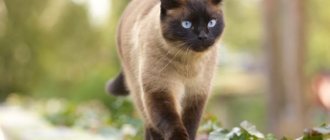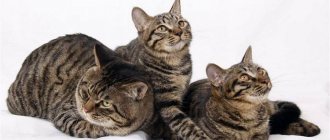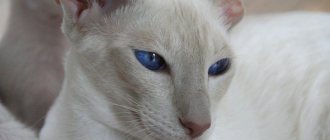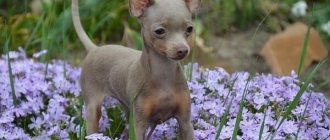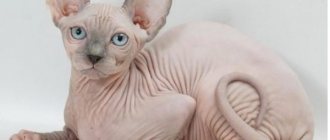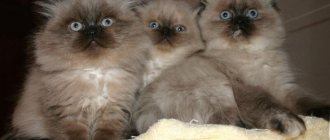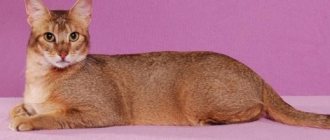It is believed that the wild lynx is the closest relative of domestic cats, but it is almost impossible to domesticate it - representatives of this species are difficult to train. Only the caracal can be considered a wild animal at home, but it is also a very risky neighbor. Therefore, numerous breeders, seeing and understanding the market demand for the external characteristics of the lynx, have been trying for a long time to develop a similar breed by crossing individuals living in the wild with their domestic brothers.
So what breeds of cats that look like lynx exist and what are their names?
Lynx at home
I would still like to say a few words about the possibility of keeping a real lynx in an apartment or house. In nature, these animals reach the size of large dogs, live in the remote taiga and are so careful that seeing them is a great success. These wild cats are capricious, have a tough character, and trying to tame an adult is extremely difficult; the maximum that can be achieved is that the animal will live in an enclosure and communicate with people through the bars.
The wild lynx is a serious and merciless animal
Professional trainers have successfully attempted to tame lynxes that came to them at a tiny age due to the death of their mother. Lynxes raised by humans or domestic animals (for example, a large breed dog) become quite accustomed to humans and their company, but their proximity to them cannot be considered completely safe. Lynxes have sharp claws and teeth; in addition, animals have the habit of attacking unexpectedly, from above, which can cause serious injury.
However, breeders working with zoos and forestries have worked to develop domesticated lynx. These are artificially bred cats obtained from mating the smallest wild lynxes and the largest domestic cats, which have similar features and coloring to lynxes. The domestic lynx is half the size of its wild relative and has a more predictable and docile character, but it cannot be said that this animal is suitable for any person. Zoologists are still working to improve the character of the breed.
Domestic lynx
The domestic lynx has retained all the external features of the wild lynx: flexibility, strong muscular build, characteristic spotted coat color, tufts on the ears. Domestic lynxes have beautiful almond-shaped eyes with a warm hazel color, a large, touching nose, and short hair with a dense undercoat. Wild relatives also passed on some of their willfulness to domestic lynxes - the pets turned out to be more similar in character to dogs, which imposes obligations on the owner to seriously raise the cat.
The domestic lynx is still an experimental breed. The Canadian lynx was chosen for its selection as the smallest representative of the genus. Feline breeders believe that this direction is very promising, since the first kittens have already been bred with an easygoing character and an appearance similar to a wild lynx.
Video - Five reasons not to get a lynx
Caracal (lynx of the steppes): description
Another type of lynx that has been adapted for domestic keeping is the caracal. In fact, these are also wild cats that live in African territories, as well as in the reserves of the Caspian Sea. This species has become rare and even endangered due to active hunting of caracals, which in turn destroy domestic animals among the local population.
“Caracal” is a Turkish name, a translation of the word “karakalak”, translated as “black ears”. It is the darkened ears that are the main distinguishing feature of the animal. The caracal's ears are large, sharp and sensitive, with brush-like hairs remaining at the tips.
Caracals are born with black ears
These cats have short, thick fur that is sandy, red or copper in color. Almond-shaped charming eyes seem to be lined with black. The ears are set high on the graceful small head. An adult caracal can gain weight up to twenty-five kilograms, and reach half a meter at the withers. The body of the animal is elongated, cats “stretch” up to almost a meter, kitties are smaller. In general, the steppe lynx is unusually beautiful and eye-catching.
In recent years, the idea of domesticating caracals has become very popular, and more than a dozen nurseries around the world are breeding this breed for indoor use. Several generations of caracals have already grown up not just in captivity, but in close contact with people, and these animals become the gene pool for even more domesticated kittens.
Domestic caracal
However, keeping a steppe lynx, even if it is a domestic one, is not within the power of everyone - these are large animals, up to fifty centimeters at the withers, that need a lot of movement and free space. Domestic caracals are not kept in small apartments; a country house with its own territory, securely fenced, is more suitable for them. Some owners keep caracals in enclosures with free access to the street, but it is better when the cat constantly lives with people and is socialized.
It is worth considering that, like their wild counterparts, domestic caracals run very quickly, calmly take the height of any tree, swim excellently, and the length of their jump can reach four meters. When equipping the territory, you need to take into account these characteristics of the animal.
Like all cats, caracals are very playful.
The ability of caracals to be tamed is high, so they were quite easily able to move from the category of wild hunters to the category of pets. However, it will not be possible to bring a wild-born kitten into the house and raise it - the animal will retain all its instincts, including distrust of humans, excellent hunting skills, and will refuse affection and communication with household members.
Therefore, you can only take caracals from a nursery where the kittens were born and saw the light of day with people. Domesticated steppe lynxes are quite friendly, curious, and do not show aggression. But, people whose children are growing up should not have such a pet. In general, raising a small caracal is very similar to raising a puppy - the pet needs to be walked, taught commands, and conditioned to live in partnership and subordination with a person.
Like dogs, caracals are good at leash training.
Character traits
In most cases, the cat, which looks similar to a wild lynx, but is a domestic breed, is adapted to life in close proximity to humans. Although they retain their independent character, they quickly become attached to their owner, often following on his heels. Many owners note friendliness and complaisance, as well as a high level of intelligence and ability to train. Lynx cats are patient and loyal to children and other pets.
But these extraordinary animals, which are often very devoted to their people, require no less attention and love.
Caraquet - small caracal
Domesticated caracals, despite their enormous cost (can be compared to the price of a new foreign car), are popular among people. But not every person is ready to take a risk and test the strength of their nervous system, interior and wallet by getting such a large cat. Therefore, zoologists created an even more domestic type of steppe lynx - the caraquet.
In 2011, the first generation of these cats was born, and the ancestors of the breed were the steppe lynx, which breeders bred with three variations of domestic cats: Orientals, Abyssinians and Egyptian Mau. The hybrid turned out to be half the size of a caracal, has an easy-going disposition and poses less danger to humans. From caracals, caracats inherited a spectacular appearance: the same sandy shade of fur coat, black ears with tassels, grace and power. At the same time, the hybrid breed has high immunity, a lot of energy and a high level of activity.
Young caraquet
Breeders have done a lot of work on the psyche of Caraquets - these cats, like all domestic breeds, are friendly, affectionate and flexible. It is the combination of exotic appearance and wonderful character that determines the high price of kittens. The cost of an animal for castration or sterilization (that is, without the right to further breeding) is about a million Russian rubles.
There are four official caraquet nurseries in Russia, and their founders set as their goal the preservation of rare cat species, as well as the breeding of new hybrid breeds. The caracat is exactly the cat that completely reproduces the caracal, which is disappearing in nature, but at the same time the animal’s aggression has been “erased.” Let us note that caraquetas are tolerant even of small children, interact well with other cats and dogs, and are able to live in an apartment without going outside.
Charming big-nosed caraquet
The history of cats with tufted ears
One of the breeds originated from the caracal or desert lynx. The wild species was crossed with an ordinary pet. Caracals have been domesticated by Asians since time immemorial. These animals have brown ears with expressive tufts at the end, and a sand-colored body. In Africa, on the contrary, they have always been considered useless animals, and even capable of causing harm, interfering with a peaceful life and running a household. They never became pets on this continent. In Asia, they helped hunters, just like greyhounds, dachshunds help residents of Europe and America. The first case of the appearance of a crossbreed was recorded in 1998. At the Moscow Zoo, kittens were born from a caracal and an ordinary large cat.
Cats that look like lynx
The hybrid offspring were found to be infertile. It soon became clear that a cross between cats and lynxes could not appear at all without the help of genetic engineering. The difference in the genetic code is too great. Further experiments stopped for some time. In 2007, the scientific community and cat lovers were shocked by the news of the birth of new hybrid kittens. American and German felinologists repeated the experiment. It was successful, however, new generations of hybrids were also infertile.
A resident of Russia from Krasnodar, Irina Nazarova, made a new attempt. This time we managed to obtain two generations of hybrids. The new breed was called Caraquets. Information about this was transferred to the International Felinological Association TICA, the Russian International Registry ICU.
Pixie bob: mini lynx for the home
A wonderful domestic breed that is most similar to the lynx when it comes to tame and affectionate cats. This artificially bred breed is the fruit of the successful work of specialists from the USA. Pixie bob translates to “elf with a short tail.”
The first kittens were born in the 80s of the last century, from a domestic pet and a wild forest cat with a short tail. The breed's characteristics, such as a pear-shaped head, a spotted coat, and powerful “whiskers” like a real lynx, were fixed over several more generations, and the pixie-bob became incredibly popular.
The pixie bob also has tassels on his ears.
The standard breed characteristics of pixies are:
- The head is large, strong, the chin is wide and powerful.
- The ears are rounded, large, with tassels at the tips (there are individuals without them).
- “Heavy” wide eyes, pronounced brow arches, eyelids drooping, creating a stern look.
- Pixie-bob kittens have sky-blue eyes from birth; by six months the iris color changes to hazel, honey or green.
- The mirror of the large nose has a brown tint, the nose itself has a slight hump.
- The physique is powerful and heavy; the weight of an adult animal can reach ten kilograms.
- Wild ancestors “gave” the pixie-bob limbs of different lengths - the hind ones are higher than the front ones.
- The pixie still has a tail - it is desirable that it be five to seven centimeters in length and slightly “broken”.
- The pixie-bob has brown fur and characteristic spots; hairs are shorter on the body and longer on the belly.
Domestic cat with wild charm
Despite the fact that pixie bobs are strikingly similar to absolutely wild cats, they are very affectionate towards humans, have a balanced and even phlegmatic character, and are strongly attached to their family. It is the combination of appearance and docileness that makes the pixie a very common and popular breed abroad. In Russia, cat lovers are just getting acquainted with pixies.
Hybrids
Those who want to place a real predator in their home are better off not taking risks and choosing an alternative in the form of a mestizo. The first generation hybrid is visually almost no different from its wild ancestors, but has a softer disposition.
Representatives of the cat family that have retained their primitive appearance include:
- caraquet;
- domestic lynx.
Caraquet
The ancestor of this lynx-like breed was a caracal crossed with a Bengal cat. Caraquetas are not small animals, whose weight can reach 15 kg. Like their predatory ancestor, they have long hind legs and tufted ears. And their spotted coat only enhances their resemblance to a lynx.
Caracats are calm, peace-loving cats. Although the animals look like a predator, they are endowed with a playful disposition. Representatives of the breed get along well in the same territory with other pets.
This lynx-like hybrid variety quickly learns to walk on a leash and needs a designated area to exercise its hunting instincts.
Domestic lynx
These animals appeared as a result of crossing ordinary cats with Canadian lynxes. They have a “wild” exterior and a gentle character. From the Canadian lynx, they inherited the “trademark” tufts on their ears, almond-shaped eyes, a gracefully arching back, long hind limbs and a short tail. They have a blue-gray or gray-brown coat.
The domestic lynx needs careful grooming and extra attention. She should be able to exercise a lot and eat raw meat.
Maine Coon: description
Maine Coons appeared in New York in the 60s of the 18th century. At that time the breed was little known, but at the turn of the 19th and 20th centuries it gained enormous popularity. At that time, Maine Coons were readily purchased by farmers, because the huge cats had serious hunting talents and could protect small pets.
Adult Maine Coon
Modern pets have retained the stamina and excellent health of their ancestors, but their character has changed over the years. From independent hunters, they turned into affectionate, loving and reverent pets. However, the behavior and psyche of Maine Coons is similar to that of a dog, which is why they are often called “cat-dogs.”
Maine Coon "wild" colors
Externally, Maine Coons still resemble wild cats - large sizes, tufts on the ears, and a variety of native colors. An adult cat is characterized by a heavy, massive jaw, large, attentive eyes, and powerful paws that cover half of a human palm. A person who wants to have a mini-copy of a wild cat in their home should take a closer look at striped, spotted or marbled Maine Coons. However, if there are colors that practically copy lynx spots.
Maine Coons are record holders
Norwegian Forest Cat: Description
The Norwegian Forest Cat is a giant with a gentle character. This breed is similar to Maine Coons due to their lush coat, impressive size and variety of colors, but the roots of these breeds are different. We can say that the first representatives of this breed appeared by chance, as a result of the mating of a domestic “spring” cat with a wild cat from the Norwegian forest. When the cat gave birth, people assessed, first of all, the hunting abilities of the grown kittens.
So they began to work on the breed purposefully. The result was large animals with a restrained, calm character, independent, but attached to home and people. These cats have a very strong psyche, adapt perfectly to any situation, and therefore are even able to travel with their owner.
Norwegian forest cat
The breed is characterized by thick wool with a dense undercoat, which protects the animal from any weather. A person looking at a Norwegian cat gets the impression of power and wild, primitive strength hidden under the gentle and gentle appearance. Indeed, modern “Norwegians” have retained all the qualities of hunters, and, if necessary, are able to defend themselves even from a large dog.
Bobtail from the USA: characteristics
This is a fairly old and well-known breed of cat, which was bred in America in the 50s. American bobtails resemble wild lynxes with a short tail, squat body structure, spots on the coat and a heavy, sullen look. These are quite large cats, capable of reaching a weight of eight to nine kilograms.
American Bobtail cat
The description of the breed includes the following characteristic features:
- Wedge-shaped, large rounded head.
- Medium-sized triangular ears topped with tassels.
- Big, open eyes.
- Athletic but stocky build.
- Wide nose.
- Flexible but short tail ranging from two to seven centimeters long.
- Elastic luxurious coat with dense undercoat.
American bobtails can have different shades of coat: black, cream, red, blue. But the most prized wild colors are “marble” and “tabby”, characterized by spots or dark patterns throughout the cat’s coat.
Marbled Bobtail
The character of the American Bobtail allows him to be a true favorite of the whole family: these cats are gentle, moderately active, obedient and loving. In addition, the breed has no health problems and is a long-living breed: up to fifteen years.
Where can I buy an exotic animal?
If you purchase a live bobcat from a nursery, an employee will likely check your living conditions. Wild lynx, as well as other large breeds, need large areas, in particular an aviary is suitable. Some of the living rare, expensive breeds can be purchased exclusively from hand. In the event that a generation can reproduce, therefore, the price will be quite high.
“Saltykovsky” is the only animal farm where you can actually buy wild lynx, located near the city of Moscow. Meanwhile, specially bred breeds are much easier to buy. Nurseries where they are bred are mainly located in large cities: Moscow, Novosibirsk, St. Petersburg, Vladivostok, etc.
The lynx-like species is easy to acquire from hand in almost any city. A certain category of people is engaged in breeding, so they will gladly sell their pupils with a pedigree and the necessary documentation.
Summarizing
Table. Comparison of cat breeds similar to lynxes
| Dimensions, weight | Cost of a kitten | Character | |
| Caracal | Weight up to 25 kilograms, at the withers up to half a meter. | From 600 thousand rubles to 1.5 million | Can be aggressive |
| Caraquet | Weight up to 15 kilograms, at the withers up to 40 centimeters. | From 500 thousand to 1.2 million rubles | An experimental breed in which breeders are trying to get rid of aggression |
| Maine Coon | Weight up to 15 kilograms, at the withers up to 35 centimeters. | 30-70 thousand rubles | Affectionate but capricious |
| Bobtail USA | Weight up to 9 kilograms, at the withers up to 30 centimeters. | 25-50 thousand rubles | Gentle, obedient |
| Norwegian forest | Weight up to 10 kilograms, at the withers up to 30 centimeters. | 25-50 thousand rubles | Independent, friendly |
| Pixie bob | Weight up to 8-9 kilograms, at the withers up to 25 centimeters. | 50-100 thousand rubles | Phlegmatic, calm, flexible |
A person who likes the appearance of a wild lynx may well have a miniature pet. There are several breeds of cats that are more or less similar to lynxes. Therefore, choose a pet that will please the eye, but not burden your wallet and everyday life.

